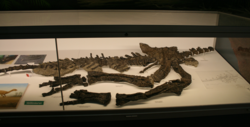Hypsilophodon
Hypsilophodon was a small, fast-running, plant-eating dinosaur. It lived 125 million years ago, was 2.3 metres long (7/8 feet), including tail, and weighed about the same as a man.
| Hypsilophodon Temporal range: Lower Cretaceous, 130–125 mya
| |
|---|---|

| |
| Hypsilophodon skeleton. | |
| Scientific classification | |
| Kingdom: | |
| Phylum: | |
| Class: | |
| Superorder: | |
| Order: | |
| Suborder: | |
| Family: | Hypsilophodontidae
|
| Genus: | Hypsilophodon
|
| Binomial name | |
| Hypsilophodon foxii Huxley, 1869
| |
It was originally thought to be a young Iguanodon which could climb trees. Later it was realised to be a different species, and to be a running dinosaur, not adapted for climbing.
Palaeobiology
Like most small dinosaurs, Hypsilophodon was bipedal and ran on two legs. Its entire body was built for running; a light-weight, low, aerodynamic posture, long legs and stiff tail for balance. All this would have allowed it to travel remarkably fast for its size.
Hypsilophodon fed on low-growing vegetation, most likely preferring young shoots and roots in the manner of modern deer. The structure of its skull, with the teeth set far back into the jaw, strongly suggests that it had cheeks, an advanced feature that would have facilitated the chewing of food. There were twenty-eight to thirty ridged teeth in the animal's jaw which, due to their alternate arrangement, appear to have been self-sharpening. As in almost all dinosaurs and certainly all the ornithischians, the teeth were continuously replaced.
The level of parental care in this dinosaur has not been defined, although a neatly-arranged nest has been found, suggesting that some care was taken before hatching. Fossils of large groups have been found, so it is likely that the animals moved in herds. For these reasons, the hypsilophodonts, particularly Hypsilophodon, have often been referred to as the "deer of the Mesozoic".
Despite living in the Cretaceous, Hypsilophodon had a number of primitive, or basal, features. For example, there were five fingers on each 'hand' and four on each foot. Most dinosaurs had fewer digits by the Cretaceous period. Also, although it had a beak, Hypsilophodon still had pointed triangular teeth in the front of the jaw. Most herbivorous dinosaurs had, by this stage, lost the front teeth altogether (although there is some debate as to whether these teeth may have had a specialized function in Hypsilophodon).
The group Hypsilophodontidae remained the same from the Upper Jurassic to the end of the Cretaceous. It is possible that this was because the animals were almost perfectly adapted to their lifestyle, therefore selective pressure, it is assumed, was low.
Hypsilophodontidae
The family named after Hysilophodon has these genera:
- Agilisaurus
- Anabisetia
- Atlascopcosaurus
- Drinker
- Fulgurotherium
- Gasparinisaura
- Gongbusaurus (= Eugongbusaurus)
- Hexinlusaurus.[1]
- Hypsilophodon
- Jeholosaurus
- Leaellynasaura
- Notohypsilophodon
- Orodromeus
- Othnielosaurus.[2]
- Koreanosaurus.[3]
- Parksosaurus
- Qantassaurus
- Thescelosaurus
- Yandusaurus
- Zephyrosaurus
Hypsilophodon Media
Fossilized skeleton of Valdosaurus from Great Britain; probable remains of this taxon were previously assigned to Hypsilophodon
O. C. Marsh's restoration in tripod-pose
1894 restoration by Joseph Smit showing the animal in both reptilian and kangaroo-like postures
Restoration of Eotyrannus chasing Hypsilophodon, with other dinosaurs from the Wessex Formation in the background
References
- ↑ Barrett P.M. et al. 2005. Small-bodied ornithischian dinosaurs from the Middle Jurassic of Sichuan, China. Journal of Vertebrate Paleontology 25:823-834.
- ↑ Galton, Peter M. (2007). "Teeth of ornithischian dinosaurs (mostly Ornithopoda) from the Morrison Formation (Upper Jurassic) of the western United States". In Carpenter, Kenneth (ed.). Horns and beaks: Ceratopsian and Ornithopod Dinosaurs. Bloomington and Indianapolis: Indiana University Press. pp. 17–47. ISBN 978-0-253-34817-3.
- ↑ Min Huh; et al. (2011). "A new basal ornithopod dinosaur from the Upper Cretaceous of South Korea". Neues Jahrbuch für Geologie und Palaeontologie, Abhandlungen. 259 (1): 1–24. doi:10.1127/0077-7749/2010/0102.








